Note
0.0(0)
AP Art History Study Guides
AP Art History Ultimate Guide
Unit 1: Global Prehistory, 30,000–500 BCE
Unit 2: Ancient Mediterranean, 3500 BCE–300 CE
Unit 3: Early Europe and Colonial Americas, 200–1750 CE
Unit 4: Later Europe and Americas, 1750–1980 CE
Unit 5: Indigenous Americas, 1000 BCE–1980 CE
Unit 6: Africa, 1100–1980 CE
Unit 7: West and Central Asia, 500 BCE–1980 CE
Unit 8: South, East, and Southeast Asia, 300 BCE–1980 CE
Unit 9: The Pacific, 700-1980 CE
Unit 10: Global Contemporary, 1980 CE to Present
Studying for another AP Exam?
Check out our other AP study guides
Chapter 8: Byzantine Art
Key Notes
- Time Period
- Early Byzantine : 500–726
- Iconoclastic Controversy : 726–843
- Middle and Late Byzantine : 843–1453, and beyond
- Culture, beliefs, and physical settings
- Byzantine art is a medieval tradition.
- Byzantine art is inspired by the requirements of Christian worship.
- Byzantine art avoids naturalism and incorporates text into its images.
- Art Making
- Works of art were often displayed in religious and royal settings.
- Surviving architecture is mostly religious.
- Often there were reactions against figural imagery.
- Theories and Interpretations
- The study of art history is shaped by changing analyses based on scholarship, theories, context, and written records.
- Contextual information comes from written records that are religious or civic.
Historical Background
- The Byzantine Empire was born from a split in the Roman world that occurred in the fifth century, when the size of the Roman Empire became too unwieldy for one ruler to manage effectively.
- The fortunes of the two halves of the Roman Empire could not have been more different.
- The western half dissolved into barbarian chaos, succumbing to hordes of migrating peoples.
- The eastern half, founded by Roman Emperor Constantine the Great at Constantinople (modern-day Istanbul), flourished for one-thousand years beyond the collapse of its western counterparts.
- Byzantines spoke Greek instead of Latin and promoted orthodox Christianity instead of western Christianity, which was centered in Rome.
- The porous borders of the Empire expanded and contracted during the Middle Ages, reacting to external pressures from invading armies, seemingly coming from all directions.
- The Empire had only itself to blame: The capital, with its unparalleled wealth and opulence, was the envy of every other culture.
- Its buildings and public spaces awed ambassadors from around the known world.
- Constantinople was the trading center of early medieval Europe, directing traffic in the Mediterranean and controlling the shipment of goods nearly everywhere.
- Icon production was a Byzantine specialty.
- Devout Christians attest that icons are images that act as reminders to the faithful; they are not intended to actually be the sacred persons themselves.
- However, by the eighth century, Byzantines became embroiled in a heated debate over icons; some even worshipped them as idols.
- In order to stop this practice, which many considered sacrilegious, the emperor banned all image production.
- Iconoclasts also destroyed images.
- Iconoclasts may have been inspired by Judaism and Islam, which forbade images of sacred figures for similar reasons.
- The unfortunate result of this activity is that art from the Early Byzantine period (500–726) is almost completely lost.
- The artists themselves fled to parts of Europe where iconoclasm was unknown and Byzantine artists welcome.
- This so-called Iconoclastic Controversy serves as a division between the Early and Middle Byzantine art periods.
- Iconoclastic controversy: the destruction of religious images in the Byzantine Empire during the eighth and ninth centuries.
- Despite the iconoclasts' early successes, it became harder to suppress images in a Mediterranean culture like Byzantium that had a long history of painting and sculpting gods before the Greeks.
- In 843, iconoclasm was repealed and images were reinstated.
- This meant that every church and monastery had to be redecorated, causing a burst of creative energy throughout Byzantium.
- Medieval Crusaders, some more interested in the spoils of war than the restoration of the Holy Land, conquered Constantinople in 1204, setting up a Latin kingdom in the east.
- Eventually the Latin invaders were expelled, but not before they brought untold damage to the capital, carrying off to Europe precious artwork that was simultaneously booty and artistic inspiration.
- The invaders also succeeded in permanently weakening the Empire, making it ripe for the Ottoman conquest in 1453.
- Even so, Late Byzantine artists continued to flourish both inside what was left of the Empire and in areas beyond its borders that accepted orthodoxy.
- A particularly strong tradition was established in Russia, where it remained until the 1917 Russian Revolution ended most religious activity.
- Even rival states, like Sicily and Venice, were known for their vibrant schools of Byzantine art, importing artists from the capital itself.
Patronage and Artistic Life
- In the Byzantine Empire, church and state were one, therefore many of the finest works of art were commissioned by both.
- Monasteries commissioned several private works. Religious works competed for space in Byzantine structures.
- Luxury-loving royals built a powerful court atelier.
- Luxury ivory, manuscript, and precious metal crafts were this atelier's specialty.
- Artists believed they were creating works for God. Pride was a sin, thus they seldom signed their names.
- Many painters were monks, priests, or nuns whose work reflected their faith.
Byzantine Architecture
- Byzantine architecture shows great innovation, beginning with the construction of the Hagia Sophia in 532 in Istanbul.
- The architects, Anthemius of Tralles and Isidorus of Miletus examined the issue of how a round dome, such as the one built for the Pantheon in Rome could be placed on flat walls.
- Their solution was the invention of the pendentive, a triangle-shaped piece of masonry with the dome resting on one long side, and the other two sides channeling the weight down to a pier below.
- A pendentive supports the dome on four corner piers.
- Since the walls between the piers do not support the dome, they can be opened for more window space.
- The Hagia Sophia has windows on each side, unlike the Pantheon, which has only an oculus in the dome.
- Middle and Late Byzantine architects introduced a variation on the pendentive called the squinch.
- Squinch: the polygonal base of a dome that makes a transition from the round dome to a flat wall
- The Hagia Sophia’s dome is composed of a set of ribs meeting at the top.
- The spaces between those ribs do not support the dome and are opened for window space.
- The Hagia Sophia's forty windows form a halo over the congregation.
- Churches in the Early Christian era concentrate on one of two forms: the circular building containing a centrally planned apse and the longer basilica with an axially planned nave facing an altar.
- The Hagia Sophia's dome emphasizes a central core and the long nave draws attention to the apse.
- Buildings in the Early period (500–726) have plain exteriors made of brick or concrete.
- In the Middle and Late periods (843–1453), the exteriors are richly articulated with a provocative use of various colors of brick, stone, and marble, often with contrasting vertical and horizontal elements.
- The domes are smaller, but there are more of them, sometimes forming a cross shape.
- Interiors feature mosaics or frescoes on upper floors and marbles of various colors on lower floors.
- Windows surround dome bases, making them low.
- Half-lights and shimmering mosaics create mysterious spaces inside arches.
- These buildings usually set the domes on more elevated drums.
- Greek Orthodox tradition dictates that important parts of the Mass take place behind a curtain or screen.
- In some buildings this screen is composed of a wall of icons called an iconostasis.
- Iconostasis: a screen decorated with icons, which separates the apse from the transept of a church
- Cathedral: the principal church of a diocese, where a bishop sits
- Icon: a devotional panel depicting a sacred image
➼ Hagia Sophia
Details
- By Anthemius of Tralles and Isidorus of Miletus,
- 532–537
- Made of brick and ceramic elements, with stone and mosaic veneer,
- Found in Constantinople (Istanbul)
Form Exterior: plain and massive with little decoration.
Form Interior:
- Combination of centrally and axially planned church.
- Arcade decoration: walls and capitals are flat and thin and richly ornamented.
- Capitals diminish classical allusions; surfaces contain deeply cut acanthus leaves.
- Cornice unifies space.
- Cornice: a projecting ledge over a wall
- Large fields for mosaic decoration; at one time there were four acres of gold mosaics on the walls. –Many windows punctuate wall spaces.
- Dome: the first building to have a dome supported by pendentives.
- Altar at end of nave, but the emphasis placed over the area covered by the dome.
- Large central dome, with 40 windows at base symbolically acting as a halo over the congregation when filled with light.
Function
- Originally a Christian church; Hagia Sophia means “holy wisdom.”
- Built on the site of another church that was destroyed during the Nike Revolt in 532.
- Converted to a mosque in the fifteenth century; minarets added in the Islamic period.
- Converted into a museum in 1935; reconverted into a mosque in 2020.
Context
- Marble columns appropriated from Rome, Ephesus, and other Greek sites.
- Patrons were Emperor Justinian and Empress Theodora, who commissioned the work after the burning of the original building in the Nike Revolt.
Image
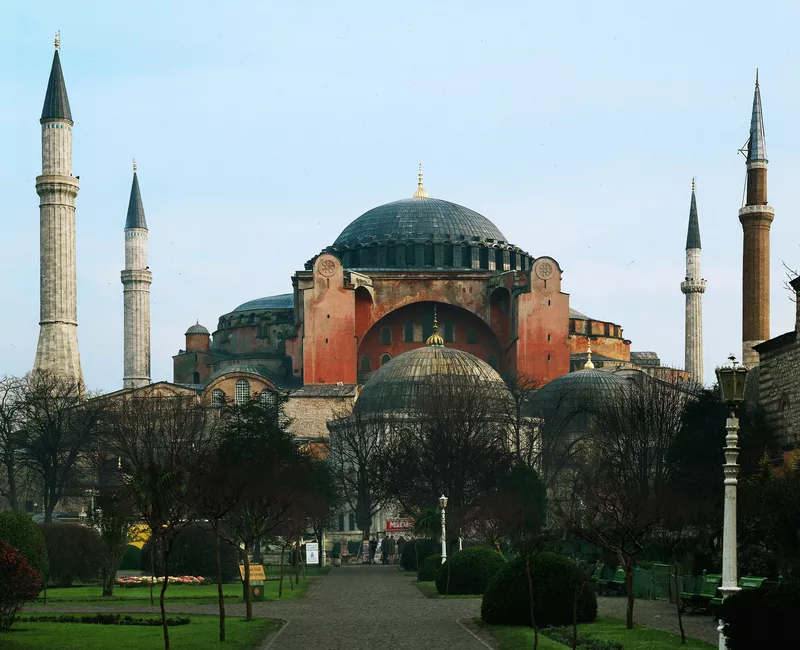
➼ San Vitale
Details
- Early Byzantine Europe
- 526–547
- Made of brick, marble, and stone veneer
- Found in Ravenna, Italy
Form
- Eight-sided church.
- Plain exterior; porch added later, in the Renaissance.
- Large windows for illuminating interior designs.
- Interior has thin columns and open arched spaces.
- Dematerialization of the mass of the structure.
- Combination of axial and central plans.
- Spolia: bricks taken from ruined Roman buildings reused here.
- Martyrium design: circular plan in an octagonal format.
- Martyrium: a shrine built over a place of martyrdom or a grave of a martyred Christian saint
Function: Christian church.
Context
- Mysterious space symbolically connects with the mystic elements of religion.
- Banker Julianus Argentarius financed the building of San Vitale.
Image
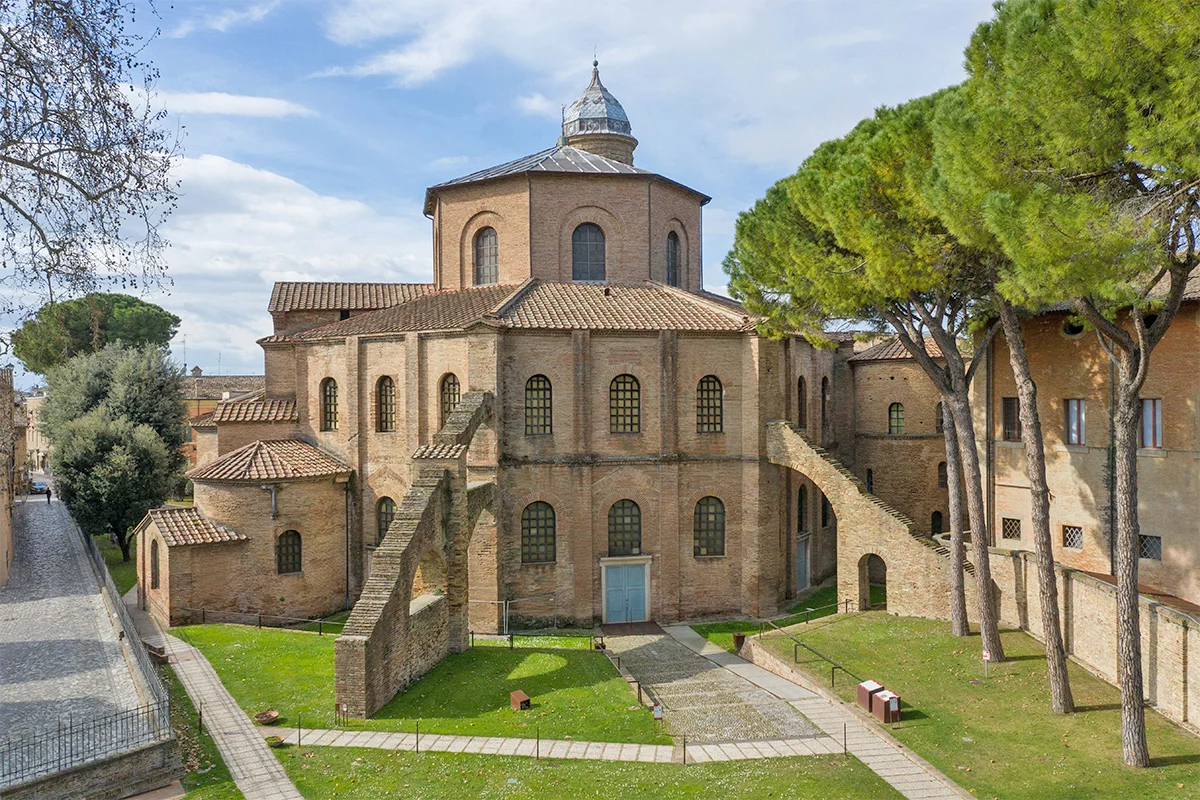
Byzantine Painting
- The most characteristic work of Byzantine art is the icon, a religious devotional image usually of portable size and hanging in a place of honor either at home or in a religious institution.
- An icon has a wooden foundation covered by preparatory undercoats of paint, sometimes composed of such things as fish glue or putty.
- Cloth is placed over this base, and successive layers of stucco are gently applied.
- A perforated paper sketch is placed on the surface, so that the image can be traced and then gilded and painted.
- The artist then applies varnish to make the icon shine, as well as to protect it, because icons are often touched, handled, and embraced.
- Icons have been blackened by candle soot and incense, and their frames burned by votive candles.
- Thus, many icons have been repainted and lost their texture.
- Icons were displayed on city walls during invasions and paraded on feast days.
- Byzantine worshippers revered them as spiritual beings.
- Byzantine painting combines classical Greece and Rome with a hieratic medieval style.
- Many artists work on the same piece, some inspired by classical tradition and others by medieval formalism.
- The Virgin (Theotokos) and Child between Saints Theodore and George shows both traditions.
- Theotokos: the Virgin Mary in her role as the Mother of God
- Classically trained artists depicted figures from unusual angles with painterly brushstrokes.
- These artists used soft color transitions and relaxed figure stances.
- Those trained in the medieval tradition favored frontal poses, symmetry, and almost weightless bodies.
- The drapery is emphasized, so there is little effort to reveal the body beneath.
- Perspective is unimportant because figures occupy a timeless space, marked by golden backgrounds and heavily highlighted halos.
- Whatever the tradition, Byzantine art, like all medieval art, avoids nudity whenever possible, deeming it debasing.
- Nudity also had a pagan association, connected with the mythological religions of ancient Greece and Rome.
- One of the glories of Byzantine art is its jewel-like treatment of manuscript painting.
- The manuscript painter had to possess a fine eye for detail, and so was trained to work with great precision, rendering minute details carefully.
- Byzantine manuscripts are meticulously executed; most employ the same use of gold seen in icons and mosaics.
- Because so few people could read, the possession of manuscripts was a status symbol, and libraries were true temples of learning.
- The Vienna Genesis is an excellent example of the sophisticated court style of manuscript painting.
- Byzantine art continues the ancient traditions of fresco and mosaic painting, bringing the latter to new heights.
- Interior church walls are covered in shimmering tesserae made of gold, colored stones, and glass.
- Each piece of tesserae is placed at an odd angle to catch the flickering of candles or oblique sunlight, creating a glittering world of floating golden shapes that may have resembled heaven to the Byzantines.
- Court customs play an important role in Byzantine art.
- Purple, the color usually reserved for Byzantine royalty, can be seen in the mosaics of Emperor Justinian and Empress Theodora.
- However, in an act of transference, purple is sometimes used on the garments of Jesus himself.
- Custom at court prescribed that courtiers approach the emperor with their hands covered as a sign of respect.
- As a result, nearly every figure has at least one hand covered before someone of higher station, sometimes even when he or she is holding something.
- Justinian himself, in his famous mosaic in San Vitale, holds a paten with his covered hand.
- Paten: a plate, dish, or bowl used to hold the Eucharist at a Christian ceremony
- Facial types are fairly standardized.
- There is no attempt at psychological penetration or individual insight: Portraits in the modern sense of the word are unknown.
- Continuing a tradition from Roman art, eyes are characteristically large and wide open.
- Noses tend to be long and thin, mouths short and closed.
- The Christ Child, who is a fixture in Byzantine art, is more like a little man than a child, perhaps showing his wisdom and majesty.
- Medieval art generally labels the names of figures the viewer is observing, and Byzantine art is no exception.
- Most paintings have flat backgrounds with one gold layer to symbolize eternity.
- In the Middle and Late Byzantine periods, figures stand before a monochromatic of golden opulence, suggesting a heavenly world.
- Codex (plural: codices): a manuscript book
➼ Justinian Panel
Details
- c. 547
- A mosaic
- From San Vitale, Ravenna
Content
- Emperor Justinian, as the central image, dominates all; emperor’s rank indicated by his centrality, halo, fibula, and crown.
- To his left the clergy, to his right the military.
- Dressed in royal purple and gold.
- Divine authority symbolized by the halo; Justinian is establishing religious and political control over Ravenna.
Form
- Symmetry, frontality.
- Slight impression of procession forward.
- Figures have no volume; they seem to float and yet step on each other’s feet.
- Minimal background: green base at feet; golden background indicates timelessness.
Function
- Justinian holds a paten, or plate, for the Eucharist; participating in the service of the Mass almost as if he were a celebrant—his position over the altar enhances this reference.
- Eucharist: the bread sanctified by the priest at the Christian ceremony commemorating the Last Supper
- Justinian appears as head of church and state; regent of Christ on earth.
Context
- Archbishop Maximianus is identified; he is the patron of San Vitale.
- XP or Chi Rho, the monogram of Christ, on soldier’s shield shows them as defenders of the faith, or Christ’s soldiers on earth.
- XP: the Christian monogram made up of the Greek letters khi and rho, the first two letters of Khristos, the Greek form of Christ’s name
Image
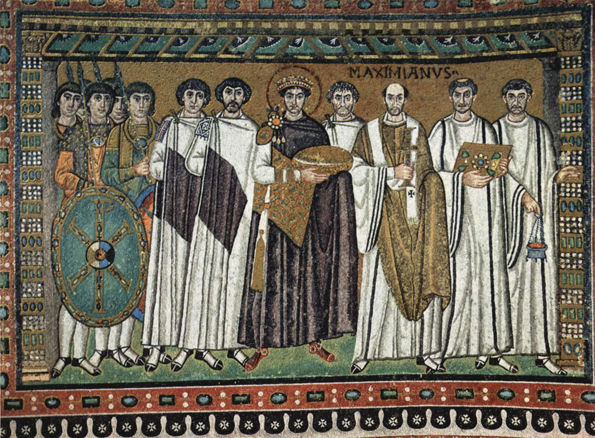
➼ Theodora Panel
Details
- c. 547
- A mosaic
- From San Vitale, Ravenna
Content
- Empress Theodora stands in an architectural framework holding a chalice for the Mass and is about to go behind the curtain.
- Chalice: a cup containing wine, used during a Christian service
Form
- Slight displacement of absolute symmetry with Empress Theodora; she plays a secondary role to her husband.
- She is simultaneously frontal and moving to our left.
- Figures are flattened and weightless; barely a hint of a body can be detected beneath the drapery.
Function
- She holds a chalice for the wine; participating in the service of the Mass almost as if she were a celebrant.
- She is juxtaposed with Emperor Justinian on the flanking wall; both figures hold the sacred items for the Mass.
Context
- Richly robed empress and ladies at court.
- The three Magi, who bring gifts to the baby Jesus, are depicted on the hem of her dress.
- This reference draws parallels between Theodora and the Magi.
Image
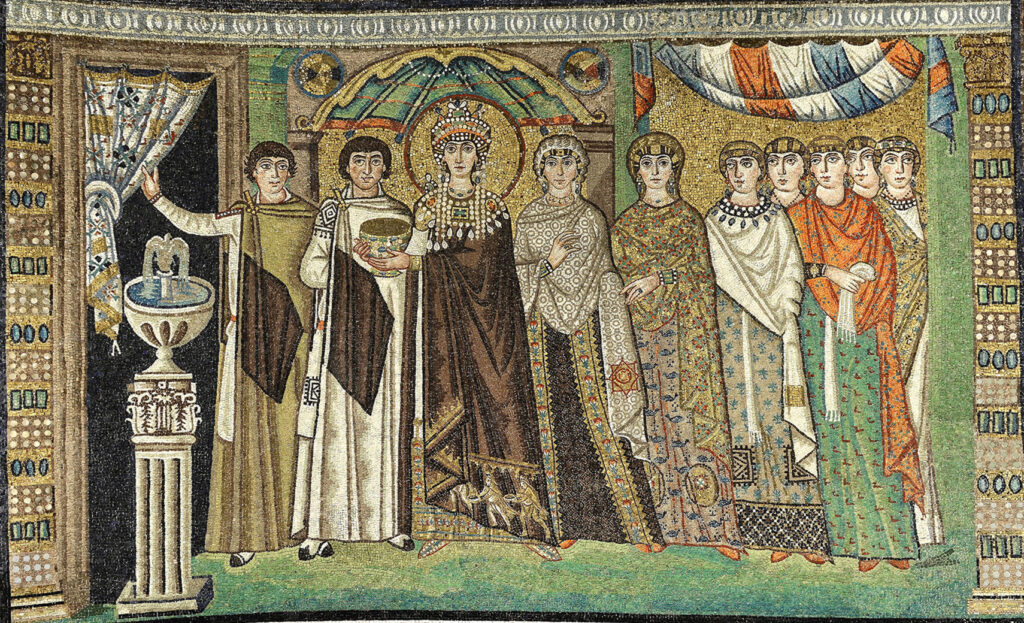
➼ Vienna Genesis
Details
- Early Byzantine Europe
- Early 6th century
- An illuminated manuscript, tempera, gold, and silver on purple vellum, Austrian National Library, Vienna
- Genesis: first book of the Bible that details Creation, the Flood, Rebecca at the Well, and Jacob Wrestling the Angel, among other episodes
- Illuminated manuscript: a manuscript that is hand decorated with painted initials, marginal illustrations, and larger images that add a pictorial element to the written text
Form
- Lively, softly modeled figures.
- Classical training of the artists: contrapposto, foreshortening, shadowing, perspective, classical allusions.
- Shallow settings.
- Fluid movement of decorative figures.
- Richly colored and shaded.
- Two rows linked by a bridge or a pathway.
- Text placed above illustrations, which are on the lower half of the page.
- Continuous narrative.
Context
- First surviving illustrations of the stories from Genesis.
- Genesis stories are done in continuous narrative with genre details.
- Written in Greek.
- Partial manuscript: 48 of 192 (?) illustrations survive.
Materials and Origin
- Manuscript painted on vellum.
- Written in silver script, now oxidized and turned black.
- Origin uncertain: a scriptorium in Constantinople? Antioch?
- Perhaps done in a royal workshop; purple parchment is a hallmark of a royal institution.
Rebecca and Eliezer at the Well
- Genesis 24: 15–61.
- Rebecca, shown twice, emerges from the city of Nahor with a jar on her shoulder to go down to the spring.
- She quenches the thirst of a camel driver, Eliezer, and his camels.
- Colonnaded road leads to the spring.
- Roman water goddess personifies the spring.
Jacob Wrestling the Angel
- Genesis 32: 22–31.
- Jacob takes his two wives, two maids, and eleven children and crosses a river; the number of children is abbreviated.
- At night Jacob wrestles an angel.
- The angel strikes Jacob on the hip socket.
- Classical influence in the Roman-designed bridge, but medieval influence in the bridge’s perspective: i.e., the shorter columns are placed in the nearer side of the bridge and the taller columns behind the figures.
Images
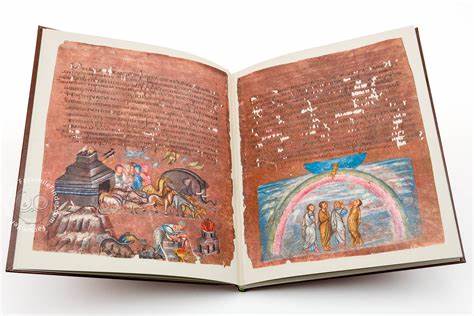
➼ Virgin (Theotokos) and Child between Saints Theodore and George
Details
- Early Byzantine Europe
- 6th or early 7th centuries
- Encaustic on wood
- Found in Monastery of Saint Catherine, Mount Sinai, Egypt
- Encaustic: a type of painting in which colors are added to hot wax to affix to a surface.
Function
- Icon placed in a medieval monastery for devotional purposes.
Content and Form
- Virgin and Child centrally placed; firmly modeled.
- Mary as Theotokos, mother of God.
- Mary looks beyond the viewer as if seeing into the future.
- Christ child looks away, perhaps anticipating his crucifixion.
- Saints Theodore and George flank Virgin and Child.
- Warrior saints.
- Stiff and hieratic.
- Directly stare at the viewer; engage the viewer directly.
- Angels in background look toward heaven.
- Painted in a classical style with brisk brushwork in encaustic, a Roman tradition.
- Turned toward the descending hand of God, which comes down to bless the scene.
- Because the three groups are in very different styles, it has been assumed that they were painted by three different artists.
Context
- Pre–Iconoclastic Controversy icon, located in the Sinai and encaustic places it near Roman-Egyptian encaustic painted portraits.
Image
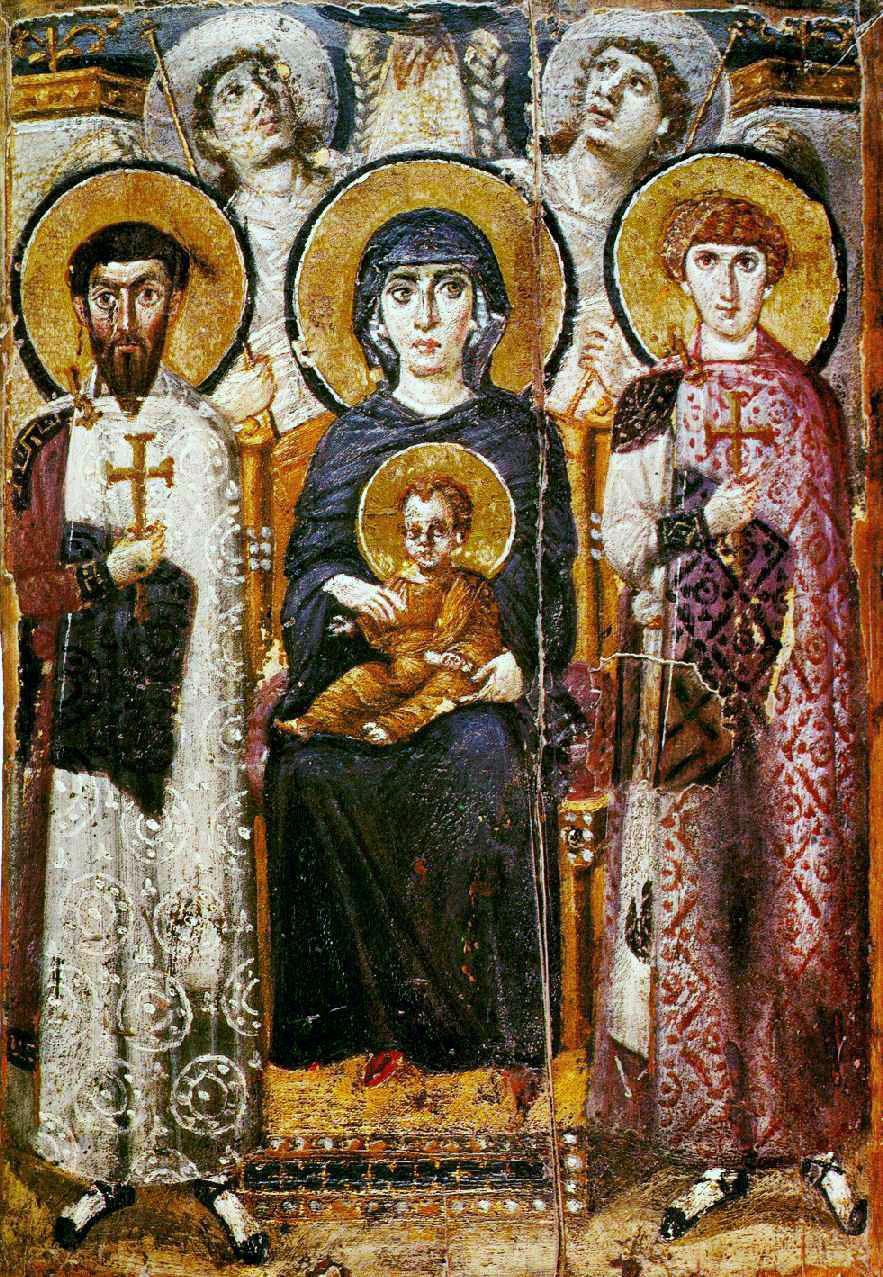
Note
0.0(0)
AP Art History Study Guides
AP Art History Ultimate Guide
Unit 1: Global Prehistory, 30,000–500 BCE
Unit 2: Ancient Mediterranean, 3500 BCE–300 CE
Unit 3: Early Europe and Colonial Americas, 200–1750 CE
Unit 4: Later Europe and Americas, 1750–1980 CE
Unit 5: Indigenous Americas, 1000 BCE–1980 CE
Unit 6: Africa, 1100–1980 CE
Unit 7: West and Central Asia, 500 BCE–1980 CE
Unit 8: South, East, and Southeast Asia, 300 BCE–1980 CE
Unit 9: The Pacific, 700-1980 CE
Unit 10: Global Contemporary, 1980 CE to Present
Studying for another AP Exam?
Check out our other AP study guides